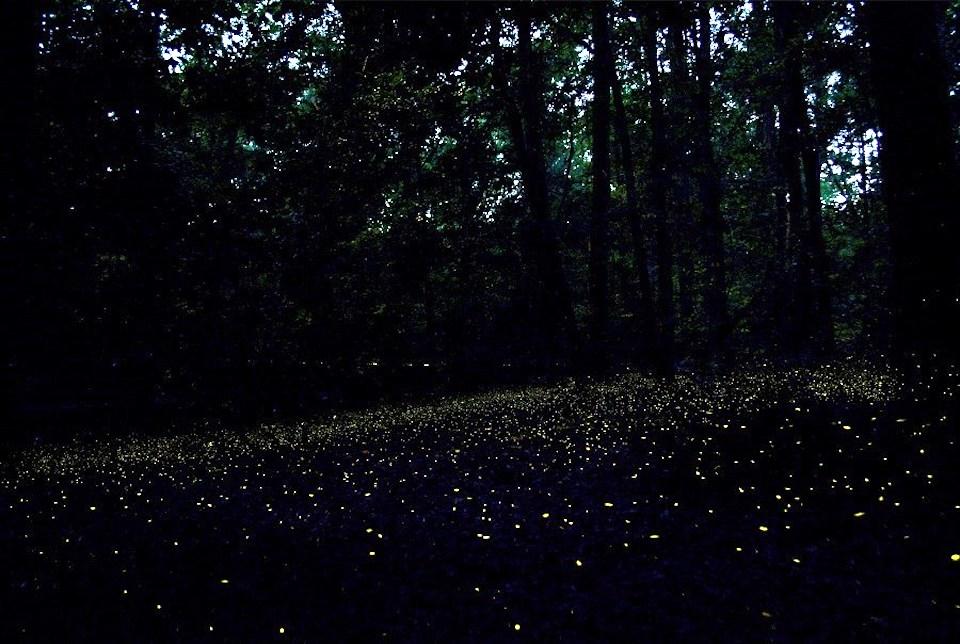
Synchronous fireflies at Great Smoky Mountains National Park/ Radim Schreiber
While watching fireflies blink off and on, sometimes all at the same time, is a growing tourism draw for places such as Congaree and Great Smoky Mountains national parks, researchers have some tips for doing so without jeopardizing the insects.
"Firefly tourism has a long history in East Asia, but this recreational activity has recently become a global phenomenon that risks overwhelming current management strategies at some locations, the researchers wrote in a recently published paper in Conservation Science and Practice, Firefly Tourism: Advancing A Global Phenomenon Toward A Brighter Future.
"A recent global survey and review discussed the major threats to firefly persistence, which include loss and degradation of larval and adult habitats, disruption of adult courtship due to light pollution, and overuse of broad-spectrum insecticides," they pointed out. "Although tourism did not emerge among the top threats globally, on a local scale tourism-related activities can have serious negative impacts. Tourism can impact firefly populations through degradation of the habitats where adult courtship takes place, as well as the habitats used for egg-laying, larval prey capture, growth and development, and pupation sites."
At Great Smoky Mountains, crowds turn out every June to see the synchronous flashing display put on by the insects near Elkmont.
"The flying insects that most of us call lightning bugs are winged beetles that are more properly termed fireflies. Whether you call this light-emitting insect a lightning bug, a firefly, or a whatever, it is a member of the Lampyridae family in the beetle order Coleoptera," Professor Bob Janiskee pointed out in a Creature Feature article that ran on the Traveler back in 2009. "The lower abdomen of a firefly has special organs equipped with chemicals that combine to produce “cold light” through a process called bioluminescence. The flashing lights help fireflies identify and evaluate potential mates. As a rule, males flash and fly while females flash and stay put."

Synchronous fireflies light up the forest at dusk in Congaree/NPS file
Last year, firefly events at both Congaree and Great Smoky Mountains were canceled due to the coronavirus pandemic. Plans for this year haven't been announced.
According to the firefly researchers, "Most visibly, tourism could directly destroy or degrade firefly habitat during the construction of associated infrastructure, such as on-site tourist facilities, jetties, resorts, restaurants, and parking lots. But tourism may also lead indirectly to habitat degradation through soil compaction and erosion, disturbance of leaf litter, water pollution or light pollution."
Best viewing practices, they said, should involve the following:
- Tourist sites must protect not only the habitats where adult courtship occurs, but also the habitats occupied by fireflies' juvenile life stages and their larval prey (e.g., forests, wetlands, grasslands for species with terrestrial larvae, rivers andponds for those with aquatic larval stages, riverbank mangrove forests for congregating mangrove fireflies).
- Economic benefits for local communities are necessary but not sufficient to ensure conservation. In addition to providing jobs and revenue, community-based tourism -- where local voices, values and knowledge are included in tourism development and management-- can promote stewardship and strengthen local institutions for managing natural resources.
- Firefly ecotourism should leverage opportunities to raise awareness about firefly life cycles and habitat requirements, and to promote conservation values more generally.
Additionally, viewers should not bring flashlights, lanterns, phones, or light-up shoes; flash photography should be banned; viewers should stay on marked trails; no loud voices; there should not be efforts to capture fireflies or disturb their display sites; no smoking or heavy perfume, and; any insect repellent, such as for mosquitoes or ticks, should be applied before reaching the viewing site.
"While firefly ecotourism has the potential to yield substantial economic benefits across multiple scales ranging from local communities, states, regions, and nations, some investment is necessary to ensure long-term survival and reproduction of the focal firefly species," the authors said.
Both Great Smoky and Congaree staff work to protect their fireflies.
At Great Smoky, for instance, a lottery system is used to distribute a set amount of tickets for viewing. Since 2006, access to the Elkmont area has been limited to shuttle service beginning at Sugarlands Visitor Center during the eight days of predicted peak activity in order to reduce traffic congestion and provide a safe viewing experience for visitors that minimizes disturbance to these unique fireflies during the critical two-week mating period.
At Congaree, staff also use dedicated viewing areas, manage pedestrian flows, and use safety lighting, among other measures. In 2019 staff created a roadside pedestrian walkway and instituted full traffic control operations to prevent vehicle-pedestrian encounters.



Comments
How do I learn more about seeing the synchronous fireflies? I thought the lottery opened today but when I got to the site, it said it was closed due to high volume. I understand I may have missed this time, but would love to know how to be prepared for the next opportunity. If you still have availability for this year, I would love to participate. Thank you!
We applied two years ago to the lottery but weren't accepted, we would like to go this year.
My husband and I have been wanting to see the fireflies forever. But we are finally visiting at the right time. We would love to know how the lottery works!!! Much appreciate! Teresa & Hugh
The lottery is already closed for great Smoky mountains. You should sign up for their newsletter and they will let you know when to apply next year. I also didn't get in but will try again in 2022